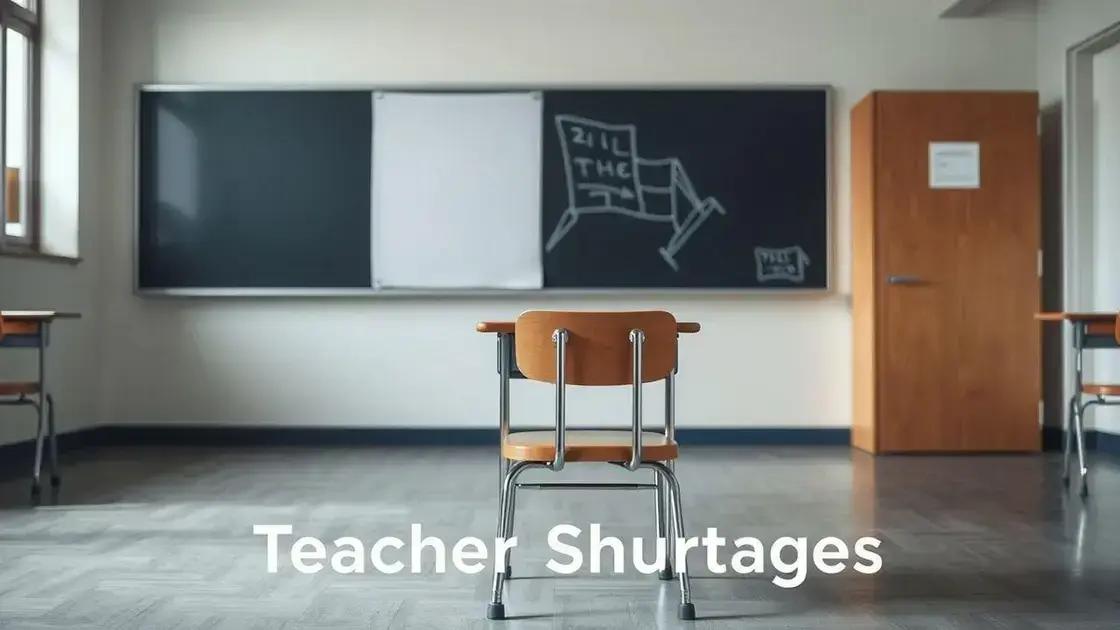Teacher shortages: understanding the crisis in education

Anúncios
Teacher shortages arise from low salaries, challenging working conditions, and a lack of resources, significantly impacting student learning and requiring strategic solutions like increased pay and improved support.
Teacher shortages pose a significant challenge for education systems around the world. Have you noticed the impact this has on our students? In this article, we’ll dive into the complexities of this issue and explore how it is shaping the future of learning.
Anúncios
The causes of teacher shortages
The issue of teacher shortages is complex and multifaceted. Understanding the root causes is essential to address this growing concern in our education system.
Economic Factors
One major reason for teacher shortages is the lack of competitive salaries. Many teachers find it challenging to support themselves and their families on the wages offered. This financial strain leads to early exits from the profession.
Working Conditions
Another critical factor is the working environment. High levels of stress and burnout are common among teachers. They often face large class sizes, limited resources, and administrative burdens. These challenges can make the job feel overwhelming.
Anúncios
Job Satisfaction
- Many teachers report feeling undervalued.
- Support from administration can be lacking.
- Limited opportunities for professional growth and development.
These feelings can contribute to a lack of retention, further exacerbating the teacher shortages crisis.
In addition, the societal perception of teaching as a less prestigious career choice affects recruitment. Young people often steer towards careers that promise higher status or financial rewards, leaving the teaching profession struggling to attract new talent.
As we examine the causes of teacher shortages, it becomes clear that a comprehensive approach is needed. From improving salaries to enhancing working conditions, each factor plays a vital role in shaping the future of education.
Effects of teacher shortages on students

The effects of teacher shortages on students are profound and far-reaching. When classrooms lack qualified teachers, students miss out on quality education and support.
Academic Performance
One major impact is on academic performance. Students in under-resourced classrooms often struggle to meet learning standards. This can lead to lower test scores and a higher likelihood of dropping out.
Increased Class Sizes
Additionally, teacher shortages often result in larger class sizes. When teachers have to manage more students, individual attention decreases. This affects the ability to address the unique learning needs of each student.
Emotional and Social Development
- Students may feel neglected or less valued.
- They may struggle to form relationships with teachers.
- This can lead to increased anxiety and behavioral issues.
Emotional support is vital for students’ growth, and a lack of teachers can hinder that development. It’s crucial for students to have mentors who can guide them through challenges.
The overall school environment changes too. When students sense instability, it affects their motivation to learn. The lack of consistent educators can create uncertainty, hindering the learning process. When classes are disrupted or when experienced teachers leave, students suffer in silence.
In summary, the effects of teacher shortages extend beyond academic issues—they influence emotional, social, and behavioral aspects of student life. Without adequate teacher support, the chances of students reaching their full potential significantly diminish.
Possible solutions to alleviate teacher shortages
Finding effective solutions to alleviate teacher shortages is crucial for the future of education. Several strategies can be implemented to address this ongoing issue.
Increasing Salaries
One significant way to attract and retain teachers is to offer competitive salaries. Higher wages can make the teaching profession more appealing. This could encourage more individuals to enter the field and reduce turnover rates.
Improving Working Conditions
Enhancing working environments is equally important. By reducing class sizes and providing better resources, schools can help teachers feel more supported. This creates a positive atmosphere where teachers can thrive, which benefits students as well.
Mentorship Programs
- Establish mentorship programs for new teachers.
- Create pathways for professional development.
- Encourage experienced teachers to provide support and guidance.
Mentorship helps new educators build confidence and skills. Experienced teachers can share valuable insights and knowledge, leading to a more robust teaching workforce.
Community engagement also plays a role. Schools can collaborate with local organizations to promote teaching as a viable career path. This includes outreach programs in high schools and colleges that highlight the importance of education and the rewarding aspects of being a teacher.
Furthermore, offering incentives for teachers to work in high-needs areas can help balance resources across regions. Programs that forgive student loans for teachers who commit to teaching in underserved communities can be a motivating factor.
To address teacher shortages effectively, a multi-faceted approach can create a supportive framework for current and future educators. By improving salaries, enhancing working conditions, fostering mentorship, and engaging communities, schools can work to reduce this critical issue in education.
Future outlook on the teaching profession

The future outlook on the teaching profession is a topic of great interest and concern. As education evolves, so too do the challenges and opportunities faced by teachers.
Growing Demand for Educators
Despite the current teacher shortages, the demand for qualified educators is expected to grow. As populations increase, more teachers will be needed in various subjects, particularly in STEM and special education fields. This growth may encourage educational institutions to invest in strategies to attract and retain teachers.
Emphasis on Technology
The integration of technology in the classroom is reshaping the teaching landscape. Teachers will need to adapt to using digital tools effectively. This not only enhances learning but also prepares students for a technology-driven world.
Continued Professional Development
- Teachers will increasingly participate in ongoing training.
- Professional development will focus on new teaching methods.
- Collaboration with peers will be emphasized.
Such initiatives can strengthen teaching practices and improve student outcomes. A commitment to lifelong learning among educators will be essential for future success.
The societal perception of teachers is also changing. As communities recognize the vital role of educators, there may be greater support for improving their working conditions and salaries. This could lead to initiatives focused on mental health and well-being, ensuring that teachers can perform their best.
Additionally, alternative pathways into the teaching profession may emerge. Programs that allow professionals from other fields to transition into teaching can diversify the workforce and bring fresh perspectives into classrooms.
Overall, the future of the teaching profession holds promise if strategic decisions are made. By investing in teachers and valuing their contributions, the education system can ensure it meets the needs of students today and in the years to come.
In conclusion, addressing teacher shortages requires a collective effort from schools, communities, and policymakers. By focusing on competitive salaries, improved working conditions, and an emphasis on professional development, we can create a supportive environment for teachers. As we look to the future, it is essential to recognize the value educators bring to our society. Investing in the teaching profession will ultimately benefit students and enhance the quality of education. Together, we can work towards a sustainable solution for the challenges faced in our classrooms today.
FAQ – Frequently Asked Questions about Teacher Shortages
What are the primary causes of teacher shortages?
The primary causes include low salaries, challenging working conditions, and a lack of support and resources for teachers.
How do teacher shortages affect student learning?
Teacher shortages can lead to larger class sizes, decreased individual attention, and lower academic performance among students.
What solutions can help alleviate teacher shortages?
Solutions include increasing teacher salaries, improving working conditions, offering mentorship programs, and engaging the community to support education.
What is the future outlook for the teaching profession?
The future looks promising but requires strategic investments in teacher support, ongoing professional development, and an emphasis on technology in education.






